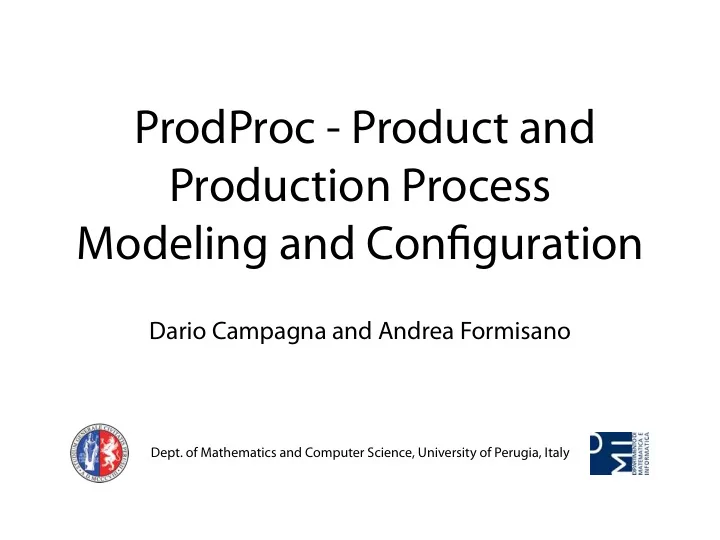

ProdProc - Product and Production Process Modeling and Con fi guration Dario Campagna and Andrea Formisano Dept. of Mathematics and Computer Science, University of Perugia, Italy
Overview • Why product and process con fi guration? • The ProdProc framework • Comparison with related work • Conclusions and future work
Product Con fi guration • Product con fi guration systems support companies deploying mass customization strategies • Many research studies have been conducted on product con fi guration • Di ff erent software product con fi gurators have been proposed in the past years
Aldanondo et al. • Mass customization needs to cover the whole customizable product cycle • Current product con fi guration systems do not explicitly cover production process problematics • Aldanondo et al. proposed to couple product with process modeling and con fi guration • Inspired by Aldanondo et al. works we devised a new framework for product/process con fi guration
The ProdProc Framework • A graphical framework for modeling con fi gurable products and their production processes • Extension of MCE and Aldanondo et al. languages • It allows one to model a product as a multi-graph and a set of constraints • It allows to model a process in terms of activities, temporal constraints, resources, etc. • It allows to couple a product with a process through a set of constraints
Process Modeling Tools • Process modeling tools (e.g. BPMN, YAWL) allows one to deal with (business) process management • They allow a user to de fi ne a process, and guide she/he through the process execution • Also within the fi led of process modeling it is possible to fi nd tools and scienti fi c works • Existing modeling language are not well suited for been coupled with a product modeling language
Product Variants Building Building first story electr./light. electr./light. first story sanitary Electr./Light. Electr./Light. Sanitary Story Story service service service floor roof ceiling upper story floor Suspended Floor Roof Story Floor ceiling ceiling roof floor Suspended Roof Floor ceiling • Tree structure • Variable representing con fi gurable characteristics • Assignments of values for variables • Assignments have to satisfy compatibility relations
Demo
Interactive Con fi guration CLP-based con fi guration system (1) Initialization (2) Choice (3) Change information information GUI Engine (XPCE) (Prolog) (4) Start inference (8) Choice process consequences User (7) Inference process results (5) CSP (6) Results CLP(FD) solver
Related Work: products • ProdProc extends MCE with cardinality variables, product model graph, cardinality (model) constraints, and meta-paths • ProdProc can be viewed as the source code representation of a system with respect to the MDA abstraction levels [Felfernig] • ProdProc covers a subset of the ontolgy presented by Soininen et al., but it is not limited to product modeling and de fi nes a rich constraint language
Related Work: processes • ProdProc combines modeling features of languages like BPMN and YAWL with a declarative approach for control fl ow de fi nition • ProdProc natively supports features that are not present in existing process modeling languages (e.g., resources, activity duration constraints, etc.) • ProdProc models allows one to describe con fi gurable processes
Conclusions • We considered the problem of product and production process modeling and con fi guration • We devised a graphical framework, called ProdProc, covering both physical and production aspects of con fi gurable products • We are implementing a CLP-based system on top of ProdProc using XPCE/Prolog • We plan to experiment our con fi guration system on di ff erent real-world application domains, and to compare it with commercial products
References • [Aldanondo et al.] M. Aldanondo and E. Vareilles. Con fi guration for mass customization: how to extend product con fi guration towards requirements and process con fi guration. J. of Intelligent Manufacturing, 19(5):521–535, 2008. • [MCE] D. Campagna, C. De Rosa, A. Dovier, A. Montanari, and C. Piazza. Morphos Con fi guration Engine: the Core of a Commercial Con fi guration System in CLP(FD). Fundam. Inform., 105(1-2): 105–133, 2010. • [Felfernig] A. Felfernig. Standardized Con fi guration Knowledge Representations as Technological Foundation for Mass Customization. IEEE Trans. on Engineering Management, 54(1):41–56, 2007. • [Soininen et al.] T. Soininen, J. Tiihonen, T. Männistö, and R. Sulonen. Towards a general ontology of con fi guration. Artif. Intell. Eng. Des. Anal. Manuf., 12:357-372, 2009. • [BPMN] S. A. White and D. Miers. BPMN modeling and reference guide: understanding and using BPMN. Lighthouse Point, 2008. • [YAWL] A. H. M. ter Hofstede, W.M.P. van der Aalst, M. Adams, and N. Russell. Modern Business Process Automation - YAWL and its Support Environment. Springer, 2010.
Recommend
More recommend